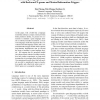Free Online Productivity Tools
i2Speak
i2Symbol
i2OCR
iTex2Img
iWeb2Print
iWeb2Shot
i2Type
iPdf2Split
iPdf2Merge
i2Bopomofo
i2Arabic
i2Style
i2Image
i2PDF
iLatex2Rtf
Sci2ools
ACL
2011
2011
Enhancing Language Models in Statistical Machine Translation with Backward N-grams and Mutual Information Triggers
In this paper, with a belief that a language model that embraces a larger context provides better prediction ability, we present two extensions to standard n-gram language models in statistical machine translation: a backward language model that augments the conventional forward language model, and a mutual information trigger model which captures long-distance dependencies that go beyond the scope of standard n-gram language models. We integrate the two proposed models into phrase-based statistical machine translation and conduct experiments on large-scale training data to investigate their effectiveness. Our experimental results show that both models are able to significantly improve translation quality and collectively achieve up to 1 BLEU point over a competitive baseline.
ACL 2011 | Computational Linguistics | Language Models | Prediction Ability | Statistical Machine Translation |
| Added | 23 Aug 2011 |
| Updated | 23 Aug 2011 |
| Type | Journal |
| Year | 2011 |
| Where | ACL |
| Authors | Deyi Xiong, Min Zhang, Haizhou Li |
Comments (0)

